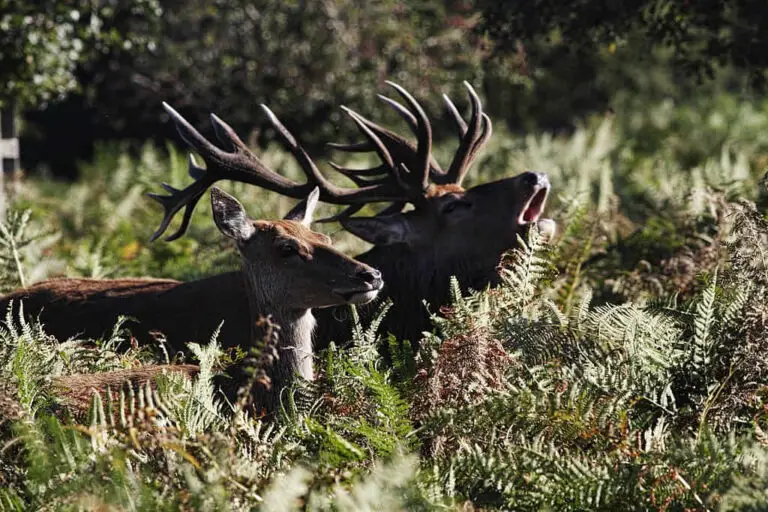
Deer, like many other animals, can be found alone for various reasons. It’s not uncommon to see a solitary deer, and there are several explanations for why a deer might be by itself:
- Young Deer Exploring: Young deer, especially fawns, may be alone as they explore their surroundings. They often hide in vegetation during the day while their mothers are away foraging and return to them later.
- Maternal Behavior: Mother deer, known as does, often leave their fawns alone for extended periods to minimize the scent trail that could attract predators. Does return periodically to nurse and care for their fawns.
- Mating Season: During the mating season (rut), male deer, or bucks, may be seen alone as they search for potential mates. They can be highly territorial and may not associate with other deer during this time.
- Older or Injured Deer: Older deer, particularly solitary bucks, may choose to live alone. Injured or sick deer might also isolate themselves from the herd to avoid drawing attention to their vulnerability.
- Food Sources: Deer may separate temporarily when searching for food sources. They often regroup when they find suitable feeding areas.
- Social Dynamics: Some deer, due to their social ranking or personalities, may prefer solitude and choose to live alone rather than in a group.
- Habitat and Human Disturbance: Human activity, habitat fragmentation, and urban development can disrupt deer herds, causing individual deer to appear alone as they navigate these changes.
- Migration: In some regions, deer undergo seasonal migrations. During these migrations, individuals might be seen alone while moving between their summer and winter ranges.
- Population Density: In areas with high deer populations, it’s common to see individual deer foraging alone because there is less competition for food resources.
- Predator Avoidance: Solitary deer may be more challenging for predators to detect and catch compared to a group of deer. Being alone can be a survival strategy.
Solitary Deer: Understanding Why a Deer Might Be Alone
The sight of a solitary deer, quietly navigating its surroundings, can evoke a sense of tranquility and wonder. However, it also raises questions about why a deer might be alone in the first place. Deer, like many other animals, exhibit a range of behaviors influenced by a complex interplay of factors, from their life stage and social dynamics to environmental conditions and individual personalities. In this comprehensive article, we will explore the various reasons why a deer might be by itself and alone.
3 Life Stages of Deer
Understanding the life stages of deer is crucial in deciphering their solitary behaviors.
Fawns: The Vulnerable Explorers
One of the most common sightings of solitary deer involves fawns. Fawns are the young offspring of deer, and they often find themselves alone for various reasons. These vulnerable explorers may venture away from their mothers to investigate their surroundings. However, they do not stray far and typically hide in dense vegetation during the day, waiting for their mothers’ return. This behavior minimizes the scent trail left by the mother, reducing the risk of attracting predators.
Motherly Love: Does and Their Fawns
Does, or female deer, are diligent mothers. They leave their fawns hidden while they forage for food. Periodically, the does return to nurse and care for their young. This motherly behavior often results in the observation of lone fawns, patiently awaiting their mothers’ return. This separation helps fawns learn survival skills while benefiting from the protective care of their mothers.
The Adolescent Phase
As deer mature, they enter an adolescent phase where they start to explore their independence. During this time, they may be seen more frequently by themselves, honing their survival instincts. It’s a critical period in their development when they learn to navigate the world on their own while staying alert for potential dangers.
3. Mating Season: When Bucks Roam Solo
Mating season, known as the rut, is a significant factor contributing to the solitary behavior of deer.
The Rut: Pursuit of Mates
The rut is a time of intense activity for male deer, or bucks. It’s when they actively search for potential mates. During this period, bucks may be seen alone as they roam in search of receptive does. They become singularly focused on finding mates and establishing dominance.
Territorial Bucks
As bucks compete for mates, they often become territorial. This territorial behavior can lead to solitary living as they defend their chosen areas from rival bucks. Solitary bucks may display aggressive behavior toward other males, which can further isolate them.
4. The Solitary Lifestyle: Older Bucks and Loner Deer
Some deer seem to prefer a solitary lifestyle throughout their lives.
Older Bucks: Going Solo
Older bucks, especially those that have experienced multiple rut seasons, may choose a more solitary existence. They have learned the ropes of survival and no longer have the same urgency to pursue mates. These bucks often establish territories where they live alone or with minimal interaction with other deer.
Loner Deer: A Matter of Personality
Just as in humans, deer can have varying personalities. Some individuals may have a natural inclination toward solitude, even as fawns. These loner deer may be seen living independently, avoiding group dynamics.
5. Temporary Separation: Foraging and Food Sources
Deer often separate temporarily while searching for food sources.
Seeking Out Food
Deer are herbivores, and their diet consists of a variety of vegetation, including leaves, grasses, and shrubs. When searching for food, they may disperse into smaller groups or forage individually. This behavior allows them to access different food sources efficiently.
Regrouping After Feeding
After feeding, deer often regroup. This regrouping is not only for social interaction but also for safety. Being in a group provides more eyes and ears to detect potential threats, such as predators.
6. Injuries and Health Concerns
Injuries or health issues can lead to solitary behavior.
Ailing Deer
Deer that are injured or unwell may isolate themselves from the herd. This behavior is a survival instinct, as it reduces the risk of drawing attention to their vulnerability. Injured deer often seek seclusion to rest and recover.
Vulnerability to Predators
In a group, injured or sick deer may slow down the entire herd, making them more vulnerable to predators. By separating themselves from the group, they reduce the risk to their fellow deer.
7. Human Impact and Habitat Changes
Human activity and habitat changes can significantly affect deer behavior.
Urbanization and Habitat Fragmentation
Urbanization and habitat fragmentation can disrupt deer herds. As natural habitats are replaced by urban areas, deer may find themselves in altered environments. This can lead to changes in their behavior and patterns, including more solitary living.
Crossing Paths with Humans
Deer might choose solitude as a response to encountering humans frequently. They can become wary of human presence and seek out less disturbed areas, further contributing to solitary behavior.
8. Migration Patterns: A Seasonal Solitude
Some deer species exhibit seasonal migration patterns, leading to temporary solitude.
Seasonal Movements
In regions with distinct seasons, deer may undergo seasonal migrations. They move between their summer and winter ranges to access suitable food and shelter. During these migrations, deer can be seen alone as they follow their traditional routes.
Following the Seasons
As the seasons change, so does the behavior of deer. Their solitary periods may correspond to particular times of the year when they are in transit between their seasonal ranges.
9. Social Dynamics: A Mixture of Interaction and Isolation
Deer are social animals with complex social structures.
The Herd’s Pecking Order
Within a deer herd, there is a hierarchy or pecking order. Dominant individuals often have better access to resources and mates. Subordinate deer may choose to be solitary to avoid confrontations with dominant members.
Social Outliers
While deer herds typically consist of family groups, there are always outliers. Some individuals may prefer solitude and avoid close interactions with other deer.
10. Population Density: Seeking Space
Population density plays a role in deer behavior.
Finding Space in Crowded Territories
In areas with high deer populations, deer might spend more time alone while foraging. This behavior allows them to reduce competition for limited food resources and find quieter spots.
11. Predator Avoidance: A Survival Strategy
For many animals, including deer, being alone can be a survival strategy.
Reducing Vulnerability
Solitary deer can be more challenging for predators to detect and catch compared to a group of deer. Being alone can reduce the risk of predation.
Safety in Solitude
Deer may choose solitude to minimize the risk of encountering predators. By moving and living alone, they reduce the chances of drawing attention to themselves through group movement and noise.
12. Respect and Conservation: Observing Solitary Deer
Observing solitary deer can be a rewarding experience for nature enthusiasts, but it’s essential to do so responsibly.
Appreciating Wildlife from Afar
If you encounter a solitary deer, remember to observe it from a respectful distance. Approaching or disturbing the deer can cause unnecessary stress to the animal.
Deer Conservation Efforts
Conservation efforts are critical to ensuring the well-being of deer populations. Habitat preservation, wildlife corridors, and responsible hunting practices all play a role in deer conservation.
Conclusion
The solitary behavior of deer is a multifaceted phenomenon influenced by a wide range of factors, from their life stages and social dynamics to environmental conditions and individual preferences. Understanding why a deer might be alone provides insights into the complex lives of these remarkable animals.
Whether they are exploring the world as fawns, seeking mates during the rut, or enjoying a solitary lifestyle, deer continue to fascinate and inspire admiration among nature enthusiasts and wildlife observers. As we share the natural world with these creatures, it’s our responsibility to respect their need for solitude and contribute to their conservation for future generations to appreciate.






